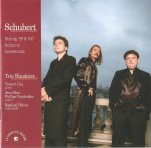The coupling here is the regular one: Schubert’s two piano trios D. 898 and D. 929; the bewitching Notturno D. 897; and the early Sonatensatz D. 28. The Trio Wanderer often captivates the ear with playing of awesome beauty–and that’s the chief caveat. These accomplished players work almost too hard to gild Schubert’s text with expressive mannerisms it doesn’t need. You feel this particularly in the B-flat trio’s slow movement development, where dialogue between the strings loses some rhythmic momentum following the cellist’s exquisite announcement of the opening theme. You can make a revealing comparison by playing this same movement by the Trio Wanderer back to back with the peerless Beaux Arts Trio version. The Trio Wanderer has yet to fully master the value of expressive understatement–absolutely vital in Schubert, where (as the Beaux Arts prove) less is so often more.
The same unchecked emotionalism occasionally dogs the equivalent movement of the E-flat work, but Vincent Coq’s piano playing is miraculously alive to every nuance of his string colleagues’ utterances, even when things get overheated in the central section. But I relished Trio Wanderer’s daring yet highly sophisticated playing of the B-flat’s striding first movement; the ensemble achieves the difficult transition into the second subject group with complete ease and a wonderful sense of unmanipulated, natural control. It’s a difficult moment that can sound lumpy and ill-prepared on disc, but the Trio Wanderer must yield to the great Beaux Arts account in the scherzos of both works, where occasional rhetoric gets in the way of purity of line, thus destroying the simplicity and purity of Schubert’s creations. Both finales have a fine sense of style and projection.
Make no mistake, as Schubertians the members of Trio Wanderer already are in the big league, and all that’s missing is that consistency of approach that only comes after lengthy involvement with these works. Harmonia Mundi’s production (from the acoustically inviting Metz Arsenal) is sonically outstanding, and these offerings should enthral. That said, seasoned collectors will probably prefer the more naturally unfolding spontaneity that the original Beaux Arts Trio (Isador Cohen, Bernard Greenhouse, and Menahem Pressler) brought to its justly acclaimed interpretations of these works, now a mid-price “must-have” on Philips Duo.
































